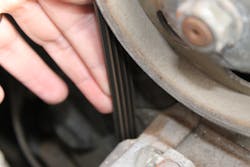Editor's note: This article was originally published Dec. 15, 2014. Some of the information may no longer be relevant, so please use it at your discretion.
Alternators serve two distinct purposes on any vehicle, the first is to provide power to meet all of the electrical needs while the engine is running (electrical system, lights, interior accessories, etc). The second is to charge the battery, so it will have enough power to prime the fuel pump, crank the engine and start the vehicle.
There are many things that go wrong with the electrical systems on a vehicle, and typically it will boil down to something other than a major component. Corrosion, grounding issues, and open circuits are the three main culprits when you are trying to find a problem, so, rather than “throwing parts at it,” first you will need to try and pinpoint what is actually wrong.
Q: Okay, so the battery connections are tight, there is no terminal/post corrosion, and the battery is charged and load tested fine… that means the alternator is bad, right?
A: Not necessarily. The next step is to verify that the drive belt that turns the alternator is properly tensioned. A belt that is “too tight” or “too loose” will cause charging issues that, in turn, will cause the problems your customer describes. Perhaps they had another shop change the motor mount two weeks ago, and the tech didn't remember to tighten the tension bolt enough, causing the belt to be too loose. It would have started fine a few times (especially if it is in mild weather and not much night-time driving, just by using the battery power). Now, the battery could have dropped to a point that there is a noticeable problem, such as a no-start situation. Always verify belt tension prior to replacing parts.
The next step will be to check the wires going from the battery to the alternator and the grounding cables. If there is corrosion, damaged wires, or loose connections at any one point with those, you will have the same issues that the customer complained about. Remember, corrosion, grounding issues and open circuits are the three major reasons for electrical problems.
If you missed the first question from this Tool Q&A, click here.


